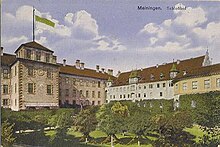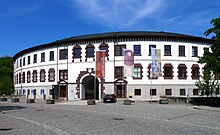Elisabethenburg Castle
The baroque Elisabethenburg Palace was the residential palace of the Dukes of Saxony-Meiningen until 1918 .
The castle is located on the north-western edge of the historic old town of Meiningen in the castle park directly on the Werra and today houses the Meiningen museums with the Max Reger archive , the Meiningen city archive and Thuringian state archive , the “Max Reger” music school, the “Johannes Brahms ”in the castle church , a restaurant, a tower café, the city administration and the wedding rooms of the registry office.
history
The Elisabethenburg Palace was built by Bernhard I , the first Duke of Saxony-Meiningen, from 1682 to 1692 in place of the former Würzburg Meiningen Castle as a three-wing complex, which is recognizable from the air as an "E" with its tower in the central axis of the main wing. Later this floor plan was often interpreted as a reference to the name of the Duke's second wife, Elisabeth Eleonore von Braunschweig-Wolfenbüttel , who was named in honor of the new residential palace Elisabethenburg . In purely structural terms, however, the shape results simply from the combination of the tower, which contains the central staircase, with the three-wing system. The central projection in front of it avoided the interruption of galleries and room lines in the main wing.
A completely symmetrical baroque three-wing complex was originally planned . Towers were to be added to the roofs of the central projection and at the ends of the side wings. This ideal design, which is shown, for example, on a thaler from 1692, was never fully implemented and only realized on the south wing.
For the construction, among other things, stones from the defensive wall of the former castle, the north-western city wall and the ruins of the Landeswehre castle were used . 1685 should for this purpose by the latter of the dungeon to be blown up, but not quite succeeded, so this is still today cracked and slanted in the ground. Furthermore, due to the need for space, private land in the south had to be acquired. The main building of the Würzburg Castle, built in 1511, today called Bibrabau after Bishop Lorenz von Bibra , was included in the ensemble as an initially unconnected north wing, as there was no money for the planned new north wing, analogous to the south wing. The builders closed the open side towards the city with a two-storey semicircular building called the rotunda . In the south wing was the palace church consecrated in 1692 "To the Holy Trinity". The castle was surrounded by a wide moat, over which the castle moat bridge led.
The areas of the moat on the park side and in front of the main entrance of the castle's circular building were piped and filled in 1809–1810, whereby the still intact castle moat bridge disappeared under the new pavement. At the same time the courtyard was paved. Between 1835 and 1837 the castle roof was rebuilt. The heavily rusticated window frames that characterize the facade today were added in 1845. Originally, the windows had more simply designed rectangular frames made of sandstone. The rotunda was raised by one storey in 1854 and in 1861, under construction supervisor Otto Hoppe, a renovation of the Bibra building took place. In 1918 the castle courtyard was given a marble fountain in the style of the Italian Renaissance with four catching bowls and mythical creatures spouting water.
From 1692 to 1918 the castle served as the residence of the Meiningen dukes . The workrooms of well-known personalities such as Max Reger , Hans von Bülow and Ludwig Chronegk were located here . Johannes Brahms was often a guest on his Meiningen work and friendship visits to the castle. The palace also housed an extensive ducal public court library , which Friedrich Schiller regularly used during his asylum in Bauerbach with the help of the court librarian Wilhelm Reinwald . The court library was brought to the Soviet Union as looted art in 1945 ; it has not been returned to the present day.
Building description
Until the beginning of the 20th century, Elisabethenburg Palace was by far the largest building in the city, with the exception of the city fortifications. Even today it is only surpassed by a few commercial and commercial buildings. The built-up area of the three-wing complex and the circular building is around 5,780 m² without ancillary buildings, with the castle courtyard it is 10,230 m². It is one of the largest castle buildings in Thuringia.
Main wing
The 112 m long and 20 m wide main wing forms the western side of the palace ensemble. A wide flight of steps leads from here to the palace gardens and the Werra. In the castle courtyard, a stair tower is placed in front of the main wing as a central projection, the top floor of which is occupied by the Hessensaal. The walls of the Hessensaal are set back a little. Outside there was a three-sided roof corridor with a balustrade, which has now been dismantled. Today there is a café in the Hessensaal with a good view of the old town. The stair tower is the main entrance to the Meiningen museums and galleries in the main wing. Architecturally, the stairwell, the marble hall, some ducal apartments and the wedding room are to be emphasized. Since 2015, a glazed external elevator south of the central risalit has offered barrier-free access.
South wing
The 50 m long and 19 m wide south wing, built at the same time as the main wing, houses the castle church . This has been used since 1978 as the “Johannes Brahms” concert hall, also known as the “Brahms Hall”. The princely crypt of the ducal house, which was used until the inauguration of the crypt chapel in the English Garden in 1839, was located in a spacious and spacious basement below the church . The giant hall, once the first Meiningen theater venue, is located above the castle church. Today the Meiningen registry office is still housed in the south wing with access to the richly decorated wedding room in the main wing.
Bibra building
The Bibra building in the Renaissance style forms the north wing of the palace ensemble and is also the oldest component. It was built in 1511 as the main building of the Würzburg Castle. In 1861 a reconstruction took place with an increase in storeys and the construction of a staircase which has since connected the Bibra building with the main wing of the palace. The building is provided with bay windows, turrets and numerous dormers. The Bibra building is the domicile of the Meiningen State Archives, the City Archives and the Max Reger Music School.
rotunda
The three-storey round building connects the ends of the south and north wings in a semicircle and delimits the castle courtyard to the east and the city. The ministries of the Duchy and the Free State of Saxony-Meiningen were housed here until 1920 ; since the destruction of the Meiningen town hall in February 1945, it has been the headquarters of the city administration. The central archway forms the main entrance to the palace ensemble. The city set up a citizens' office on the ground floor north of the gate. To the south of this, the ground floor is occupied by a restaurant.
Castle courtyard
The castle courtyard has been redesigned several times over the centuries. Initially an open area, around 1900 it was densely planted with trees and hedges. Today a wide ring path lined with benches and small hedges leads to all staircases and entrances to the castle buildings. In the center there is a three-shell marble fountain in a green area with paved paths. In the summer half of the year, the art object "Angel of the East", also called ReinCARnated, is sporadically exhibited by the pop artist Anne Schwegmann-Fielding in the south-west corner near the castle church . This is a disused Trabant 601 , which she has completely covered with a fine mosaic of fragments of porcelain, colored glass and mirrors, as well as photographs and other pieces from the GDR era.
Museum in the castle
Elisabethenburg Palace is now one of the Meiningen museums and houses the most extensive art collection in Thuringia. The main wing of the palace, used as a museum , consists of 52 rooms with 3400 m² of exhibition space.
The exhibitions and collections in the castle are structured as follows:
- Historic interior - from the playful Rococo to elegant Empire to historicism .
- Art collections on two floors - paintings, sculptures, furniture, ceramics, clocks and other handicrafts from different centuries.
- Music history - exhibitions about the Meininger Hofkapelle and the musicians Johann Ludwig Bach , Richard Wagner , Hans von Bülow, Johannes Brahms , Richard Strauss , Max Reger. Furthermore, Reger's study is shown in the Max Reger Archive and a historical musical instrument collection is presented in a new permanent exhibition (since November 2008).
- Theater history - about the Meininger Theater and the Meininger .
There are also two galleries in the castle, in which historical exhibits on a current cultural or communal topic are presented in constantly changing exhibitions .
literature
- Ingrid Reissland: The Meiningen Schloss Elisabethenburg. Building history and significant interiors. State museums, Meiningen 1988.
- Verona Gerasch (Ed.): Contributions to the colloquium: 300 years of Elisabethenburg Castle (= South Thuringian Research. Volume 27.) State Museums, Meiningen 1992, ISSN 0585-8720 .
- Alfred Erck et al. (Hrsg.): Lexicon for the history of the city Meiningen. Bielsteinverlag, Meiningen 2008, ISBN 978-3-9809504-4-2 .
- Alfred Erck, Hannelore Schneider: Elisabethenburg Castle in Meiningen. In: Roswitha Jacobsen, Hendrik Bärnighausen (Hrsg.): Residenz-Schlösser in Thüringen. Cultural-historical portraits. Quartus-Verlag, Bucha bei Jena 1998, ISBN 3-931505-39-1 , pp. 91-104.
- Wolf-Dieter Raftopoulo: Rhön and Grabfeld culture guides. A complete documentation of the old cultural landscapes in terms of art and cultural history. RMd Verlag, Gerbrunn 2017, ISBN 978-3-9818603-7-5 , pp. 198–199.
- Ingrid Reissland: The Meiningen Schloss Elisabethenburg. Building history and significant interiors. Staatliche Museen Meiningen, Meiningen 1988, DNB 1044490055 .
Web links
- Elisabethenburg Castle . In: Thueringen.info
- Elisabethenburg Castle . In: Schatzkammer-Thueringen.de
- Museum in Elisabethenburg Palace . In: MeiningerMuseen.de
- Museum in Elisabethenburg Palace . In: Museen.Thueringen.de
Coordinates: 50 ° 34 ′ 13 ″ N , 10 ° 24 ′ 46 ″ E








